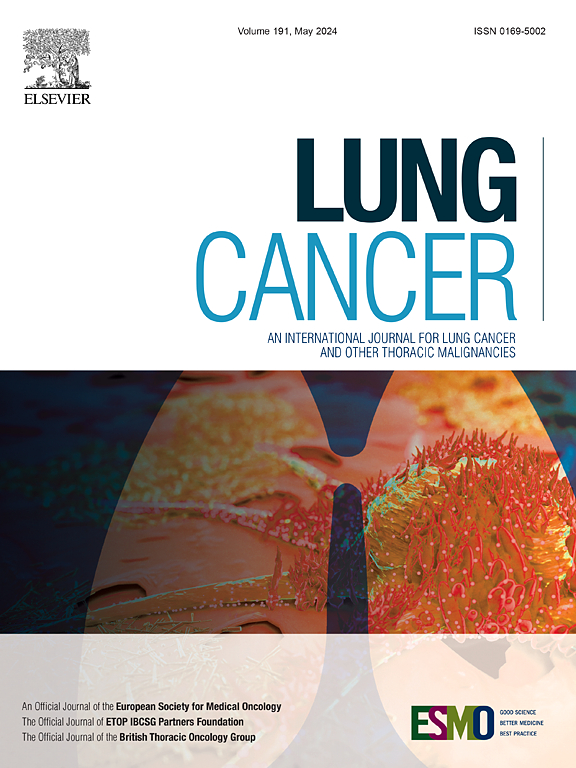Efficacy and safety of consolidative thoracic radiotherapy for Extensive-Stage Small-Cell lung cancer in the era of immunotherapy: A Real-World study
IF 4.4
2区 医学
Q1 ONCOLOGY
引用次数: 0
Abstract
Background and purpose
To evaluate the safety and efficacy of consolidative thoracic radiotherapy (cTRT) for extensive-stage small cell lung cancer (ES-SCLC) patients in the era of first-line chemoimmunotherapy.
Materials and methods
We retrospectively analyzed patients with ES-SCLC who accepted first-line platinum-based chemotherapy plus immunotherapy in our hospital from January 2018 to December 2021. CTRT was recommended for patients who achieved complete response (CR)/ partial response (PR) / stable disease (SD) after first-line systemic therapy. Patients were divided into cTRT and non-cTRT groups based on their receipt of cTRT. Categorical variables were compared using the Chi-squared test or Fisher’s exact test. Overall survival (OS) and progression-free survival (PFS) were calculated using the Kaplan-Meier method, with comparisons by the log-rank test. Univariate and multivariate analyses were employed to identify prognostic factors for OS using the Cox proportional hazards model. Cumulative incidence of local regional progression (LRP) was calculated using the Fine-Gray competing risks regression model.
Results
We finally enrolled 100 patients in our cohort, comprising 48 patients who received cTRT and 52 who did not. The cTRT group exhibited significantly younger age distribution (72.9 % <65 years vs. 50 % in non-cTRT, p = 0.019), limited metastatic sites (≤1 metastatic site: 66.7 % vs. 32.7 %, p < 0.001), and fewer liver metastases (12.5 % vs. 32.7 %, p = 0.017), alongside higher PCI uptake rates (27.1 % vs 0 %, p = 0.001). The cTRT group had significantly longer median OS (26 vs. 17 months, p = 0.006) and PFS (10 vs. 6 months, p = 0.005) compared with the non-cTRT group. Multivariate analysis identified cTRT as the only prognostic factor correlated with improved OS (HR = 0.48, p = 0.04). The LRP at 1 year were 55.4 % and 22.3 % in the non-cTRT and cTRT group, respectively (p < 0.001). 3 (6.3 %) patients had grade 3 radiation esophagitis and 5 (10.4 %) patients developed grade 1–2 radiation pneumonitis in the cTRT group.
Conclusion
The administration of cTRT is safe and holds potential benefits for ES-SCLC patients responding to first-line chemoimmunotherapy.
在免疫治疗时代,胸部巩固放疗治疗广泛期小细胞肺癌的疗效和安全性:一项现实世界研究。
背景与目的:评价在一线化疗免疫治疗时代,胸部巩固放疗(cTRT)治疗广泛期小细胞肺癌(ES-SCLC)患者的安全性和有效性。材料和方法:回顾性分析2018年1月至2021年12月在我院接受一线铂类化疗加免疫治疗的ES-SCLC患者。在接受一线全身治疗后达到完全缓解(CR)/部分缓解(PR) /病情稳定(SD)的患者推荐使用CTRT。根据患者接受cTRT的情况将患者分为cTRT组和非cTRT组。使用卡方检验或Fisher精确检验比较分类变量。采用Kaplan-Meier法计算总生存期(OS)和无进展生存期(PFS),采用log-rank检验进行比较。采用Cox比例风险模型进行单因素和多因素分析,以确定OS的预后因素。使用Fine-Gray竞争风险回归模型计算局部区域进展(LRP)的累积发生率。结果:我们最终入组了100例患者,其中48例接受了cTRT, 52例未接受cTRT。结论:cTRT给药是安全的,对于ES-SCLC患者对一线化学免疫治疗有反应具有潜在的益处。
本文章由计算机程序翻译,如有差异,请以英文原文为准。
求助全文
约1分钟内获得全文
求助全文
来源期刊

Lung Cancer
医学-呼吸系统
CiteScore
9.40
自引率
3.80%
发文量
407
审稿时长
25 days
期刊介绍:
Lung Cancer is an international publication covering the clinical, translational and basic science of malignancies of the lung and chest region.Original research articles, early reports, review articles, editorials and correspondence covering the prevention, epidemiology and etiology, basic biology, pathology, clinical assessment, surgery, chemotherapy, radiotherapy, combined treatment modalities, other treatment modalities and outcomes of lung cancer are welcome.
 求助内容:
求助内容: 应助结果提醒方式:
应助结果提醒方式:


